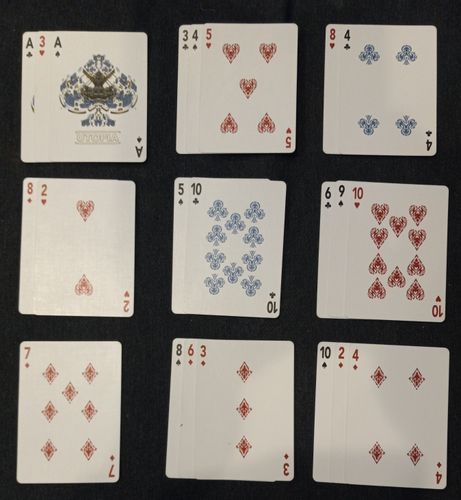|
Advertisement
|
Skyway

DescriptionIn Skyway, you are a city planner in charge of designing a notoriously convoluted traffic interchange. Over three passes through the deck, you will be drafting stacks of cards from a random market, which you’ll place into a 3x3 grid. However, each grid cell may only be stacked three cards high - any more and the bottom cards get discarded. Your aim is to create a path of at least 5 increasing cards for each of the four suits. Skyway is a solo pattern-building game playable with a deck of regular playing cards, with rules created by Wil Su and made available free online as part of his "Isaludo" series. On each turn, the player deals stacks of cards to a market, and then chooses one stack to build inside a 3x3 grid. Over three passes through the deck, the player tries to construct the grid in such a way as to create a five-card sequence in each suit -- a pathway formed by the cards that can snake around or intersect with the other suits' pathways. The catch is that each square on the grid can only hold a stack of cards three high, and placing the one card needed to complete one pathway may very well cause a card crucial to another pathway to be discarded. Arranging tiles to create maps is a cornerstone of many great city-building games like Suburbia and Sprawlopolis. However, most games of this genre require more information on each card than a simple rank-and-suit system can provide. Skyway takes its cue from the Decktet game Aucteraden. By allowing a single space to have more than one “suit” on it, the paths can intersect and weave around each other to create a small, tight puzzle. Game DiscussionsAdd CommentYou need to be logged in to comment. Insert Bullet List Please enter at least one item. Item: Item: Item: Item: Item: Insert Numeric List Please enter at least one item. Item: Item: Item: Item: Item: Insert Link Please enter the link of the website Optionally you can add display text Insert Email Please enter the email address Optionally add any display text Insert Image Please enter the link of the image Insert YouTube Video Please enter the link of the video Marketplace | ||||

Comments (0)